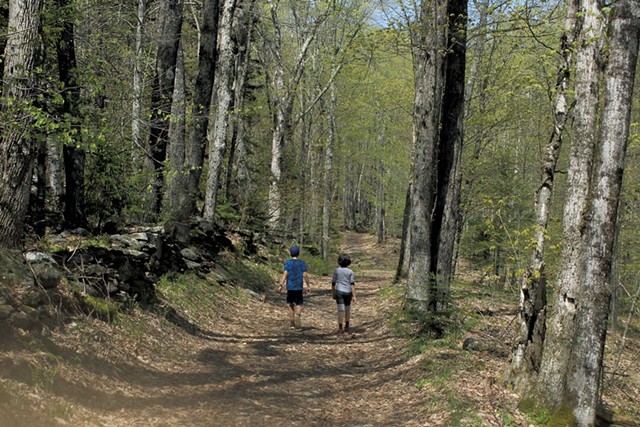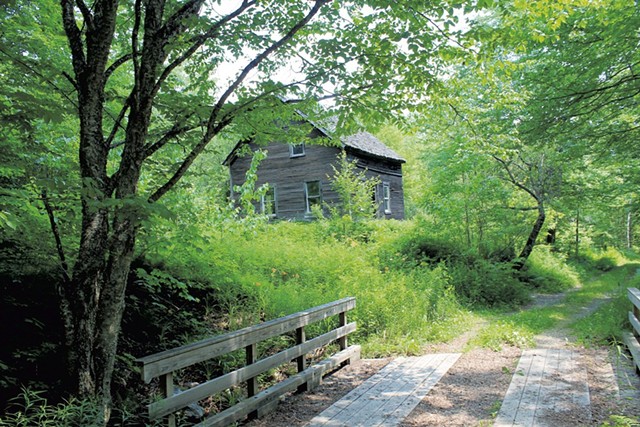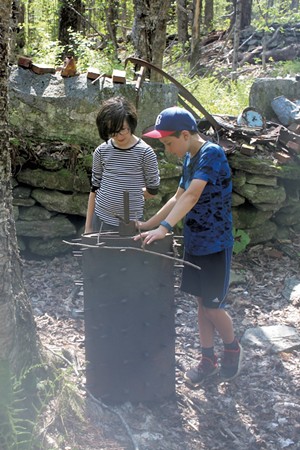
- heather fitzgerald
- Heather's son Jesse and friend Scarlett exploring the trails at Little River State Park
Little River State Park in Waterbury offers many activities, including boating and swimming on the Waterbury Reservoir, camping, and mountain biking. But what I really love are the hiking trails, which bring to life the land use history of Vermont's forests.
As a college ecology and environmental science instructor, I'm kind of a geek about this stuff. And I'm willing to bet that if you step onto these trails, you'll become one, too. Starting to see the stories in the stone walls and cellars of houses and barns that settlers built — and the lilies, lilacs and apple trees they planted — can deepen your experience of the woods.
Indigenous people have lived in Vermont since 7000 BC. Then, from the mid-1700s to the early 1800s, European settlers moved in and chopped down almost all of the forests. They planted crops and grazed animals, including a massive number of sheep, for much of the 19th century, until societal forces, such as the Civil War and the greener pastures of the Midwest, led to widespread abandonment of the hill farms and regrowth of the forests. Little River gives visitors a glimpse of this relatively brief, but impactful, chapter in the history of Vermont forests.

- joanne pereira
- Ricker Cemetery
The park's website explains: "In the early 1800s, pioneers cleared fields, rocks, and stumps in Ricker Basin and Cotton Brook. A settlement of 50 or so families once lived in this area. The hard demands of the land and weather forced younger generations to abandon the farms. Today, old cemeteries, sawmill remains, old town roads, bridges and many cellar holes can still be seen as evidence of a past community."
My advice for hiking at Little River is that less is more. There are miles and miles of trails with evidence of the old settlement. Looking at the History Hike brochure, available online and at the park's visitor center, you might feel pressured to take on the entire 8.2 miles of trails and see every notable place described. But even a short excursion provides the opportunity to learn a lot.
One option is to head counterclockwise on the Dalley Loop Trail (which is also part of the Hedgehog Hill Loop Trail). Though the numbered sites go clockwise, heading the opposite way will bring you to my son's favorite place in short — though steep — order. Within a half-mile you'll see the large cellar holes of Gideon Ricker's old farmhouse and barn, plus some interesting artifacts, including farm machinery and an old bed frame. I recommend bringing a lunch and eating it here. If you continue a short distance, you'll come across Ricker Cemetery, where many of the people who lived in the farmhouse are buried. If you turn around and head back down the hill here, your entire trip will be about a mile and a half.

- joanne pereira
- The Almeron Goodell farmhouse
On a warm and humid day, the Nature Trail might be an even better choice. The entire loop runs a cool and shady half-mile along Stevenson Brook, and leads hikers past a former pasture, two cellar holes and a beaver pond, all with informative signs.
Or maybe you want to head off trail. Stumbling upon an old sap bucket or a patch of long-ago planted day lilies on your own is worth 50 interpretive sign posts. If you do take this option, it's especially important to check for ticks when you get home. My family has established a habit of putting all of our clothes in the laundry immediately upon returning home from any above-freezing nature outing and visually inspecting each other for ticks.
Once you see the signs of land use at Little River, you might start to notice evidence of this chapter in Vermont's history elsewhere.
There are two easy clues to land use history you can look for in any patch of woods you find yourself in. When you see a stone wall, if the stones are fist-sized, that indicates that the land nearby was likely cultivated. You wouldn't remove such small stones from the dirt for fun — only if you had to do it to keep from breaking your plow. Larger stones suggest that the surrounding land was used as pasture. You can corroborate your stone-wall observations by looking at the ground. If the land is flat, it was likely smoothed by a plow, but if there are undulations left by trees that fell over and rotted in place, then it was not plowed.

- heather fitzgerald
- Scarlett and Jesse examining old farm machinery
If you find yourself wanting to know more, the book Reading the Forested Landscape: A Natural History of New England by Vermont ecologist Tom Wessels is a quick read about land use history and other major disturbances that affect our forests. It's basically a picture book for adults, with beautiful etchings by Brian D. Cohen at the start of each chapter showing all of the interesting things you might see in the woods, if only you knew where to look.
Only campers can swim at Little River. (The closest swimming beach on the reservoir for day hikers is a 20-minute drive away, at Waterbury Center State Park). My son and his friend were satisfied to stop for a brief walk along the top of the Waterbury Dam as we drove out of the park. The rangers also recommended a walk with the park's interpreter, an option for day hikers. Contact the park for the schedule; previous walks have included hikes to various cellar holes, "Art in the Park" walks to make plaster casts of animal tracks and even a "Night Ghost Hike" to Ricker Cemetery.










Comments
Comments are closed.
From 2014-2020, Seven Days allowed readers to comment on all stories posted on our website. While we've appreciated the suggestions and insights, right now Seven Days is prioritizing our core mission — producing high-quality, responsible local journalism — over moderating online debates between readers.
To criticize, correct or praise our reporting, please send us a letter to the editor or send us a tip. We’ll check it out and report the results.
Online comments may return when we have better tech tools for managing them. Thanks for reading.